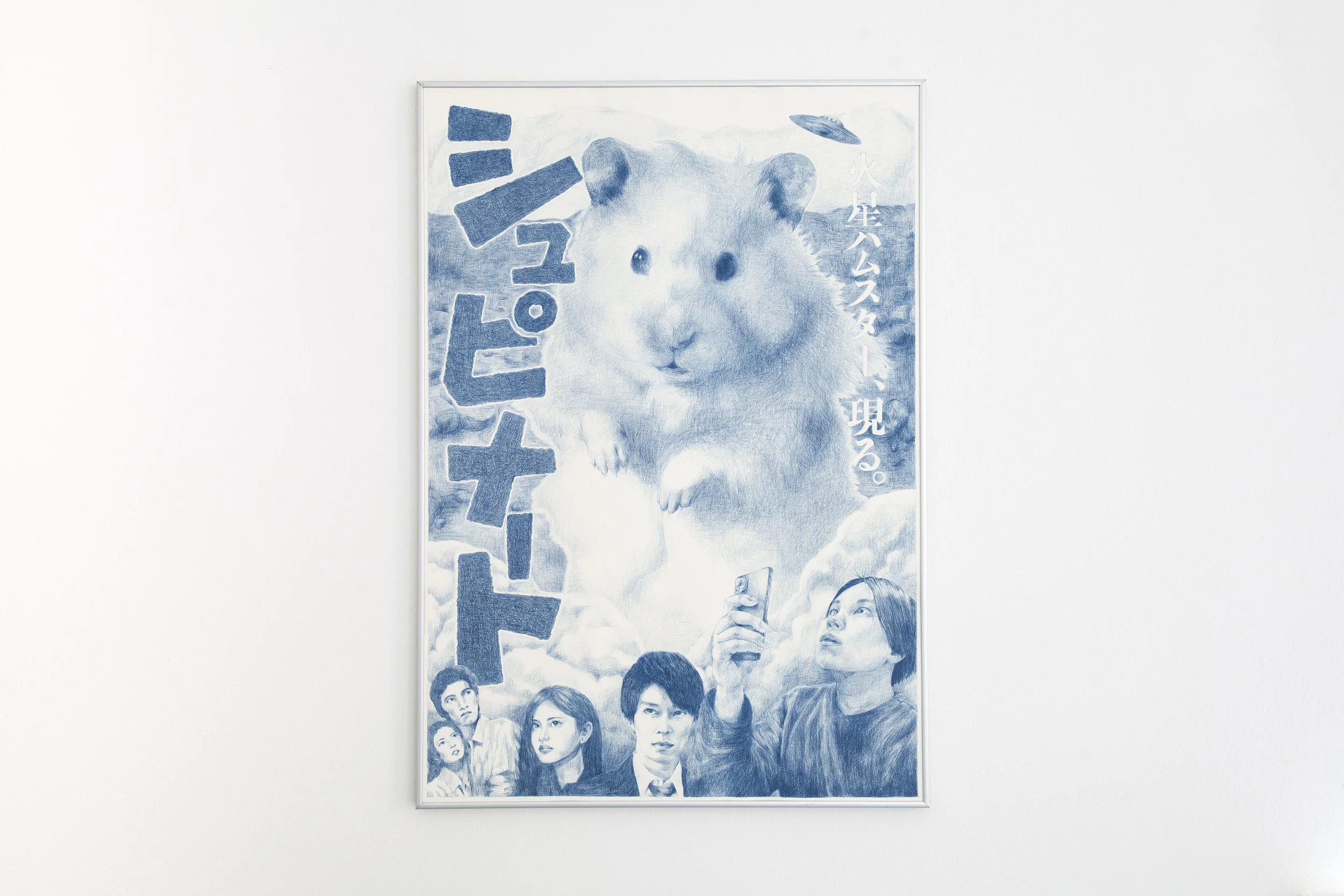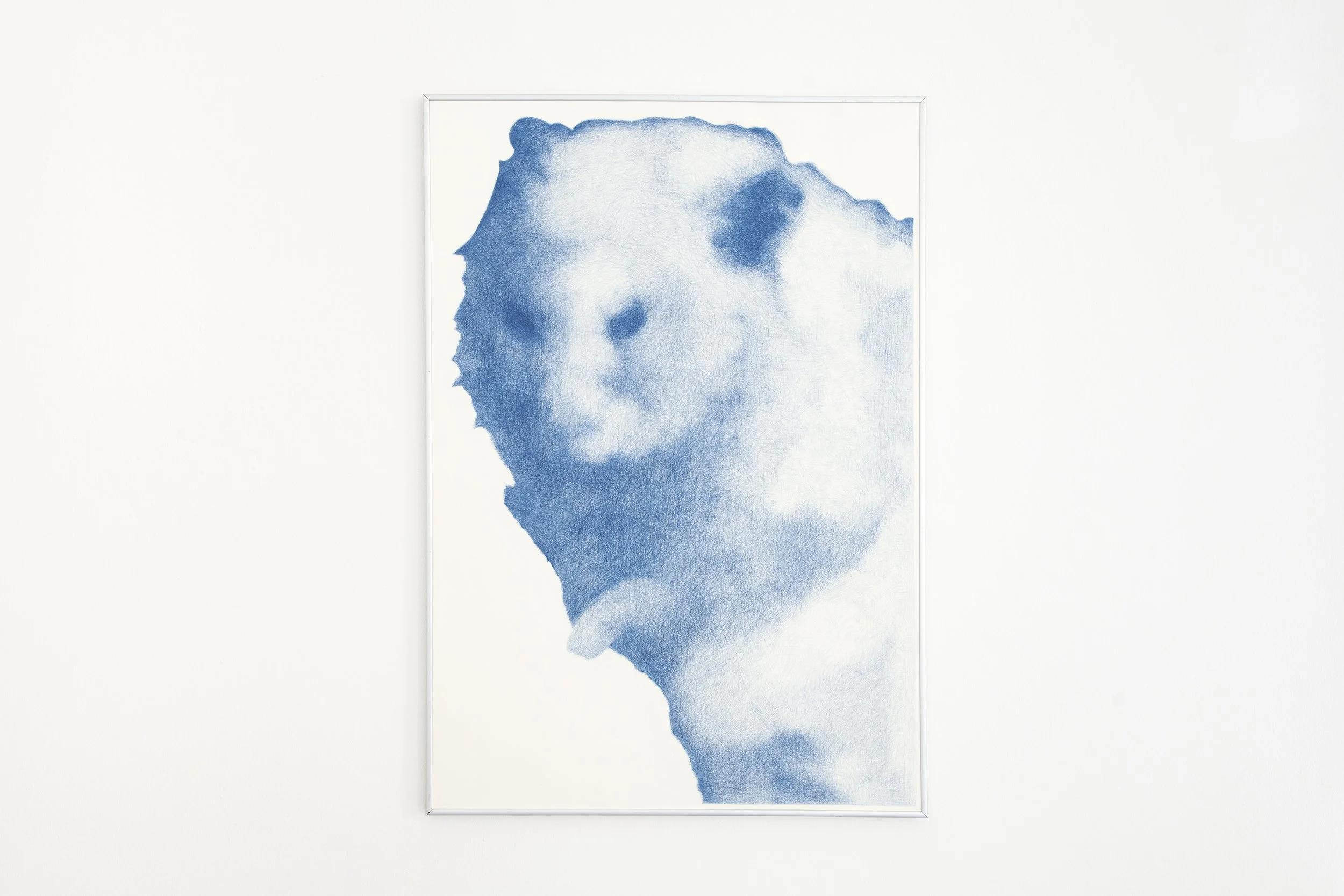Rainbow-Radiation, 2024
Acrylic color pencil, acryl on canvas, 250 x 180 cm
BLUEPRINT, 2024, Blueback poster paper, 356 x 252 cm
“Spinat, the martian Hamster, appears.” 2024, Acrylic color pencil on paper, 100 x 70 cm
Text from the diploma thesis “super fiction“, by Rio Usui Exhibition at Berkaer str.11 Bauhaus-University Weimar, 1-3. July 2024Photos by Nathalia Atuero
ゴジラ Godzilla is one of the most famous science fiction films familiar to everyone inJapan today. Godzilla was released in 1954 as a special effects film by Toho, directed by Ishiro Honda, based on the novel by Shigeru Kayama, and featuring special effects by Eiji Tsuburaya. 34 films have been made about Godzilla and the other great monsters that emerged from Godzilla's world up to 2024. Historically, it can be seen as a homage to the 1953 American special effects film"The Beast from 20,000 Fathoms" (directed by Eugène Lourié, Warner Bros. Entertainment Inc.)The main plot of the film, in which a large dinosaur suddenly appears in a civilized society and attacks a city, causing people to panic, is almost the same. However, Godzilla in 1954, used atomic and hydrogen bomb testing and radiation as metaphors. About eight months before the film's release, a hydrogen bomb test was conducted off the Bikini Atoll under the leadership of the U.S. military during the Cold War. The explosion of the hydrogen bomb test was unexpectedly large, and many fishing boats were caught in the blast and exposed to radiation. One of these vessels was the Daigo Fukuryu Maru 第五福竜丸, a pelagic tuna fishing boat. All 23 members of the crew were exposed to radiation, and acute radiation symptoms were confirmed. In Japan at that time, nine years after the atomic bombings of Hiroshima and Nagasaki during World War II, it was a great shock that civilians would be harmed by radiation exposure. The film begins with a field investigation following the sudden sinking of a cargo line off the Ogasawara Island in Japan. From the testimony of a crew member who survived the sinking, the protagonists are informed that the cause of the sinking was an attack by a giant unidentified creature. In the same village where the investigation was conducted, the giant sea monster was called Godzilla “呉爾羅” and a legend was passed down from generation to generation. Later, Godzilla landed in the center of Tokyo from Tokyo Bay, melting and destroying the Diet Building and Tokyo Tower, then symbols of postwar reconstruction, with the radiation released from its mouth. After Godzilla attacked Tokyo, people affected by the attack began to show symptoms of radiation exposure. The film also suggests that Godzilla is an ancient creature awakened by the damage of the hydrogen bomb and, by extension, the very embodiment of nature that has been contaminated and transformed by humans. At the end of the film, Serizawa, a scientist invents a destructive agent called "Oxygen Destroyer オキシジェン・デストロイヤー," which destroys all oxygen in the water in an instant, suffocating all living creatures, and then dissolves them in a liquid. Serizawa himself was sacrificed while Godzilla was dissolved and exterminated. The film ends with a lament to both Serizawa and either Godzilla. After 62 years later, Shin Godzilla シン・ゴジラ (Directed by Hideaki Anno), released in 2016, pays detailed homage to the 1954 Godzilla film, depicting the political turmoil that followed Godzilla's attack on modern Japanese society, as well as the effects of radiation and construction following the tsunami and nuclear accident that followed the 2011 Great East Japan Earthquake. Fiction フィクション is not only an imaginary and unscientific expression but is also supported by real-life events and facts. In addition, the icon of Godzilla represents the subconscious of humankind and its awe 畏怖 of nature, which cannot be completely denied, despite the fantastical nature of the giant creature. More than half a century after its release in1954, the concept of Godzilla remains a symbol of the historical difficulties, destruction 破壊, and rebirth 再生and scrap-and-build that Japan has experienced, and is still being produced, reflecting the changes and phenomenon of the times. The historical and geographical aspects of Japan, where destruction and rebirth always occur side by side in the form of atomic bombs, earthquakes, tsunamis, etc., and the universal awareness of having to forcefully accept phenomena and facts that suddenly overturn the every day and occur before our eyes, carry over the fictional existence of"Godzilla" into the present.Gaze, 2024
Acrylic color pencil on paper, 100 x 70 cm
super fiction (2024)
Installation; Drrawing, painting, prints, cutting sheets











